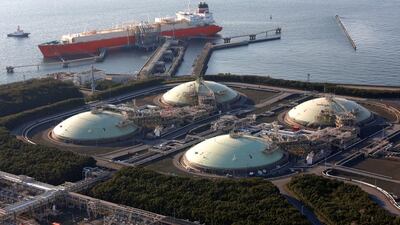More liquefied natural gas (LNG) coming into the market will keep prices depressed despite an increase in demand from Asia, analysts said.
LNG producers are ramping up from Qatar to Australia and the United States, while Egypt is expected to emerge as a new export player.
Australia has increased its market share in the first half of the year to 20 per cent from 12 per cent last year, according to BMI Research, and its exports are forecast to grow by 23 per cent over the financial year to the end of June, according to Australian energy advisory firm, EnergyQuest.
“Over FY17, production increased from almost every Australian LNG project and both Western Australia and Queensland boosted their state outputs to higher levels,” said Graeme Bethune, EnergyQuest chief executive.
Asian demand for LNG is fuelling the market, but that surge may be short-lived. Australia supplied 44 per cent of Chinese LNG imports, 31 per cent of Japan’s and 21 per cent of South Korea’s imports, according to BMI Research.
Analysts agree that South Korea, the world's No. 2 LNG importer after Japan, will continue to experience an uptick in demand over the short-term, which will help producers such as Australia and the United States.
BMI Research said that US LNG is thriving as the expansion of the Panama Canal has helped North American shipments to North Asian markets become more cost-competitive. South Korea’s imports are set to grow at an annual rate of 1 to 2 per cent as president Moon Jae-In plans to phase out coal and nuclear-fired power stations.
Mr Moon has temporarily closed 10 older coal plants and halted the construction of two nuclear facilities. BMI said that the loss in coal and nuclear generation capacity will be offset by a comparable increase in generation based off natural gas and renewable energy sources.
However, UK consultancy Energy Aspects geopolitical analyst, Richard Mallinson, said that it would take awhile to fully enact Mr Moon’s plans to slash coal and nuclear power in the country. “We expect LNG imports to increase by around 7 per cent in South Korea based on the strength so far and the need to refill stocks ahead of winter,” he said. “But next year, we think imports will fall as a number of new coal power plants are coming online by the end of this year.”
In addition, Qatar, the world's biggest LNG exporter, has announced plans to ramp up its production, though questions surround the economics. The country said it plans to increase its LNG exports by 30 per cent over the next five to seven years after removing the moratorium on development of the giant North Field.
______________________________________
Read more:
______________________________________
Energy Aspects expects half of the Qatar's target capacity additions, up to 12 million tonnes per annum (Mtpa) by around 2021, to come from debottlenecking existing trains while new trains will be needed to deliver the remaining target. However, Qatar may face issues securing long-term offtake agreements, which means that the country and its partners will take on merchant risk. "In the current market environment, Qatar is not likely to find long-term buyers for 25 Mtpa of liquefaction capacity. But taking all that merchant risk means that other LNG projects, such as in Western Canada, East Africa or even the southern US will face an even more difficult environment to place supply," Energy Aspects said.
And with this excess supply flooding the market, Egypt looks to shift from an importer to exporter with the Zohr field. The mega gas discovery, is expected to start producing 1 billion cubic feet (bcf) this year ramping up annually until it reaches 2.7bcf a day at the start of 2019.
______________________________________
Read more:
Egypt will focus on deepwater gas finds
______________________________________
Mr Mallinson said he expects the new supplies to keep prices depressed. “Australia and the US are the main sources of incremental LNG, but once the Zohr field starts this year, it will accelerate the process of turning Egypt from an LNG importer back into an exporter,” he said. “But there is healthy demand growth in several regions and the outlook for 2018 has improved to the extent that we no longer expect prices to fall far enough to close the export arbitrage for US LNG going into international markets for much of next year.”

